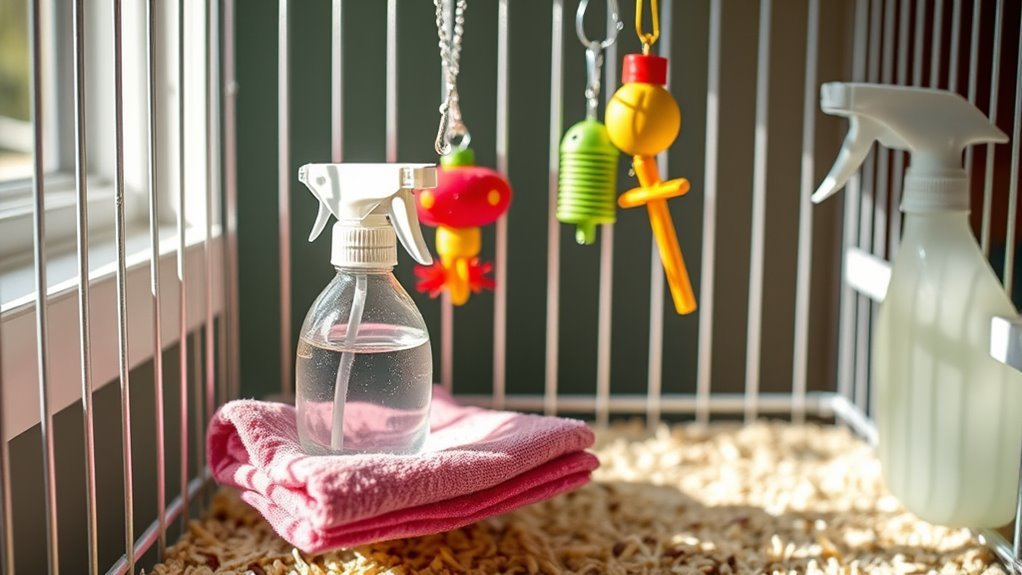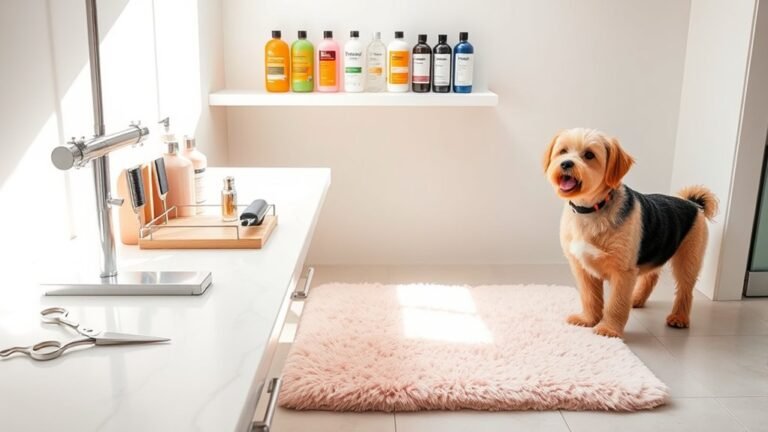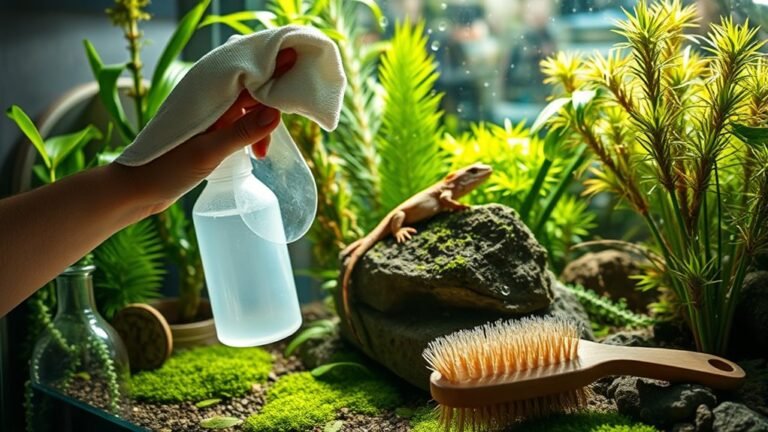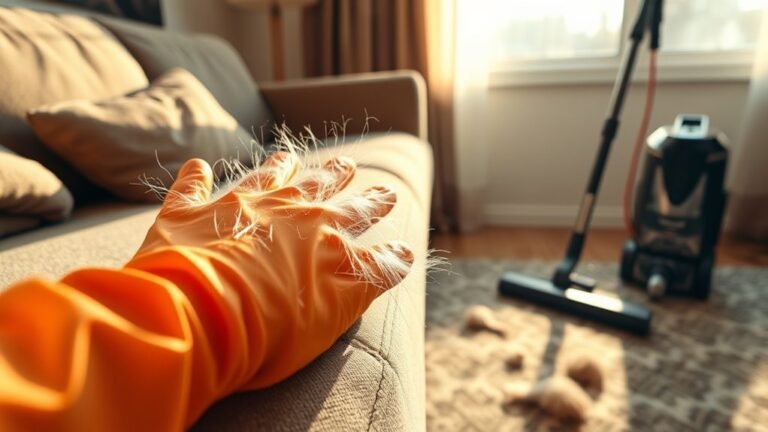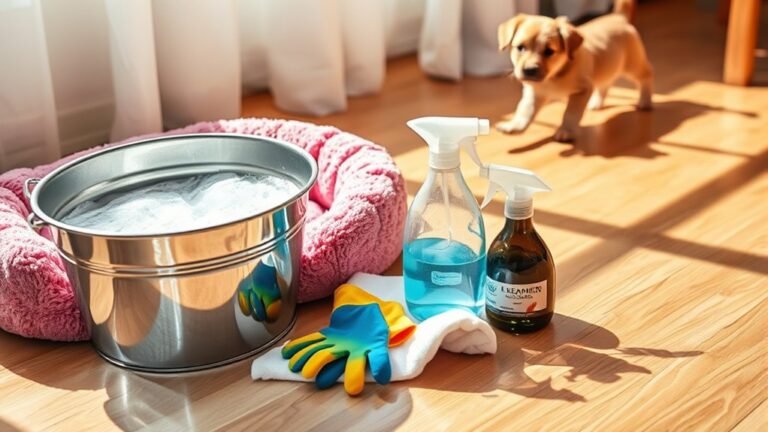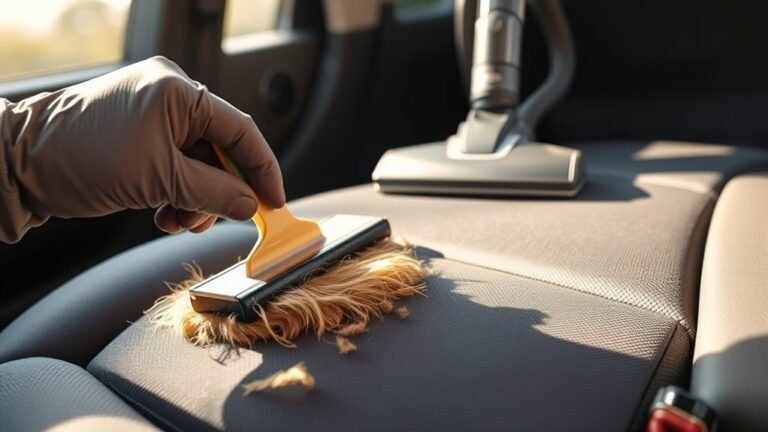How to Clean a Bird Cage Safely and Effectively
To clean your bird cage safely, start by gathering non-toxic, bird-friendly cleaning supplies. Move your bird to a comfy temporary spot to reduce stress. Remove and soak cage accessories in gentle solutions like diluted vinegar, then scrub thoroughly. Clean the cage bars and base with a soft brush and rinse well to make certain no residue remains. Make sure the cage is completely dry before putting everything back for your bird’s health and comfort. Keep going to find out how to keep the cage fresh longer.
Gather Safe Cleaning Supplies
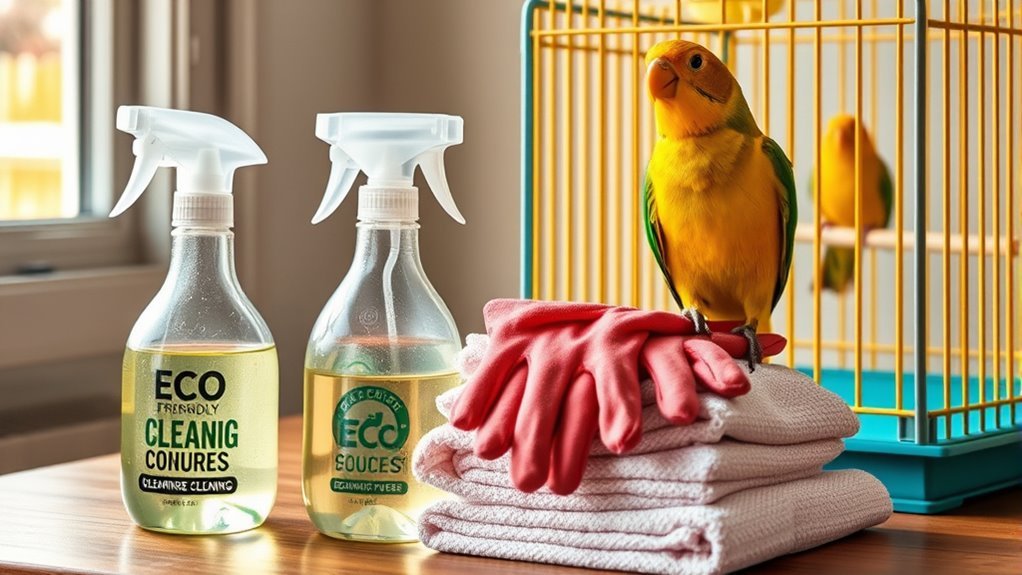
Before you begin cleaning your bird cage, you’ll want to gather supplies that are both effective and safe for your feathered friend. Choosing eco friendly cleaners is key to maintaining a healthy environment free from harsh chemicals. Look for natural, non-toxic solutions that won’t harm your bird’s respiratory system or skin. Essential supplies include a soft brush, cloths, and a spray bottle for applying your eco friendly cleaner. Gloves can protect your hands, but make certain they’re bird-safe if your pet will be around. Having a small bucket for rinsing and a sturdy trash bag for waste will streamline the process. By preparing these carefully selected, safe materials, you guarantee your bird’s freedom to thrive in a clean, non-toxic habitat.
Prepare Your Bird for Cage Cleaning
Before you start cleaning, make certain to move your bird to a safe, temporary spot where it feels comfortable. Use gentle handling and soothing tones to keep your bird calm throughout the process. This helps reduce stress and guarantees your bird stays safe while you clean its cage.
Temporary Bird Placement
While you’re getting the cage ready for cleaning, you’ll need to safely move your bird to a temporary spot. Choosing the right temporary bird placement options helps keep your feathered friend comfortable and secure without restricting their freedom. Consider alternative bird housing that offers enough space to move and explore. Here are some ideas:
- Use a smaller travel cage designed for short stays
- Set up a playpen with plenty of perches and toys
- Place your bird in a quiet room with natural light and no hazards
- Utilize an aviary or screened-in porch for fresh air and freedom
- Provide familiar items like favorite toys or a cozy blanket
Selecting the right temporary home guarantees your bird stays relaxed and happy during the cleaning process.
Minimize Stress Techniques
Although cage cleaning is essential, it can be stressful for your bird, so you’ll want to take steps to keep them calm and comfortable throughout the process. Start by speaking softly and moving slowly to avoid startling them. Offering a favorite treat or toy can serve as effective calming techniques, helping to distract and soothe your feathered friend. Creating a quiet, dimly lit environment also supports stress reduction, preventing sensory overload. If possible, let your bird watch you prepare for cleaning, so they understand what’s happening. Maintaining routine during these times reassures your bird, promoting trust and minimizing anxiety. By prioritizing these stress reduction methods, you guarantee your bird feels safe and secure while you care for their living space, respecting their freedom and well-being.
Safe Handling Practices
When you’re ready to clean your bird’s cage, handling them safely is essential to prevent injury and reduce stress. Understanding your bird’s behavior helps you approach with confidence, ensuring safe handling. Your goal is to keep your bird calm and free as you prepare the cage.
- Approach slowly to avoid startling your bird
- Use gentle, steady movements to encourage cooperation
- Support their body firmly but without squeezing
- Offer a familiar perch or hand to step onto
- Keep interactions positive with soothing tones
Remove and Disinfect Cage Accessories
Start by taking out all the removable items from the cage, like perches, toys, and feeding dishes. Make sure to clean them thoroughly using bird-safe cleaning solutions to avoid any harmful residues. This step helps keep your bird’s environment healthy and fresh.
Detach All Removable Items
Remove all removable items from the cage, including perches, toys, and food dishes. This step is vital to give your bird’s space a thorough clean and maintain its freedom to explore a fresh environment. Carefully detach these items to avoid damage or stress to your feathered friend. Gather your cleaning tools before starting to streamline the process.
Here are key removable items to focus on:
- Perches of various sizes and textures
- Hanging toys and swings
- Food and water dishes
- Ladders and ropes
- Nesting boxes or hideouts
Once detached, soak and scrub each item with appropriate cleaning tools to eliminate buildup and bacteria. This guarantees a safe, hygienic space where your bird can feel truly free.
Use Safe Cleaning Solutions
Although cleaning your bird’s cage is crucial, it’s important to use safe cleaning solutions that won’t harm your feathered friend. When you remove and disinfect cage accessories, steer clear of harsh chemicals. Instead, opt for natural alternatives like vinegar solutions—they’re effective and safe. Mix equal parts white vinegar and water to create a gentle yet powerful cleaner that cuts through grime without leaving toxic residues. Soak removable items such as perches, toys, and food dishes in the solution, then rinse thoroughly with fresh water. This approach not only protects your bird’s health but also lets you maintain freedom from toxic fumes. By choosing these safe, natural methods, you guarantee a clean, healthy environment where your bird can thrive freely.
Clean Cage Bars and Base Thoroughly
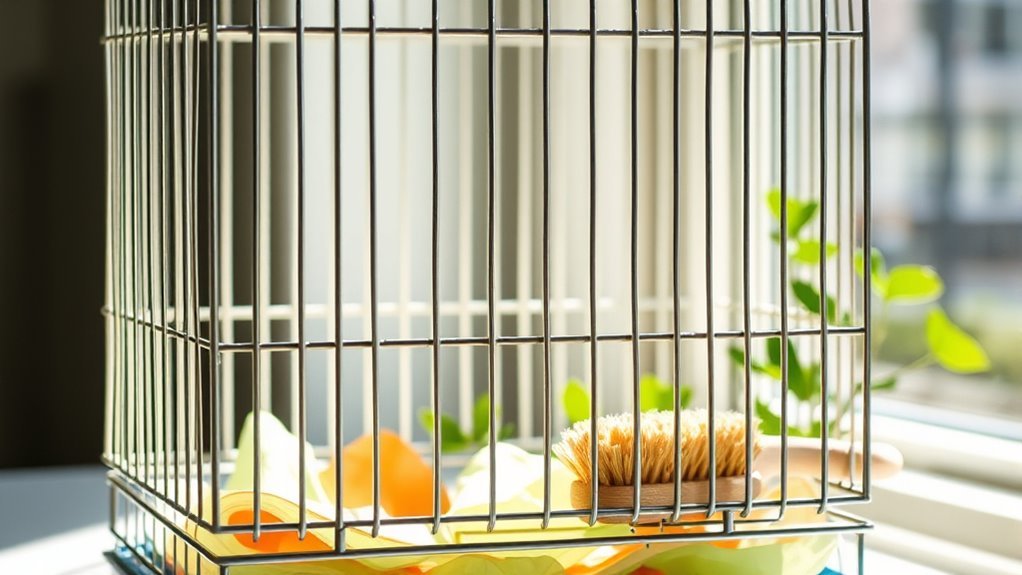
Before you move on to reassembling the cage, make certain you clean the bars and base thoroughly to remove all dirt, droppings, and residue. Proper cage bar cleaning and base sanitation are essential for your bird’s health and your peace of mind. Use a brush or sponge with a safe cleaner to scrub every corner. Don’t skip the base—you want to eliminate hidden grime.
Here’s how to get it right:
- Scrub cage bars with a non-toxic cleaner
- Pay special attention to joints and corners
- Remove and clean the base tray separately
- Use a stiff brush for stubborn spots
- Disinfect base after cleaning for extra protection
This thorough approach guarantees freedom from harmful buildup, keeping your bird’s home fresh and safe.
Rinse and Dry the Cage Completely
Once you’ve thoroughly cleaned the cage bars and base, the next step is to rinse away any remaining cleaner or residue. Using effective rinse techniques, such as a gentle spray of warm water or a damp cloth, guarantees you remove all traces of soap or disinfectant that could harm your bird. Be thorough but gentle—avoiding harsh jets that might bend bars or splash mess around. After rinsing, focus on drying methods that prevent moisture buildup, which can lead to mold or rust. Wipe the cage with a clean, dry towel and allow it to air dry completely in a well-ventilated space. By rinsing and drying the cage completely, you create a fresh, safe environment that supports your bird’s freedom and health.
Reassemble the Cage and Maintain Cleanliness
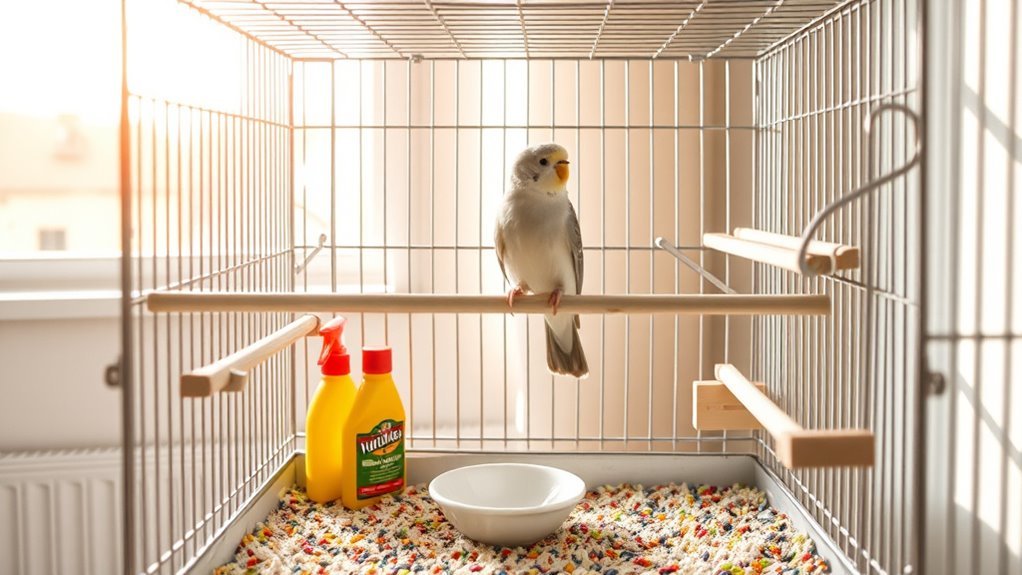
Reassembling the cage carefully guarantees your bird’s environment stays secure and comfortable. Following cage reassembly tips helps make certain everything fits perfectly, preventing escapes or injuries. Start by checking every latch and hinge, then add perches and toys in safe spots. To keep freedom in your bird’s life, adopt ongoing maintenance strategies that make cleaning quicker and less disruptive.
Here are some handy tips:
- Confirm all parts are dry to avoid rust or mold
- Tighten screws and secure doors firmly
- Replace any worn or damaged components
- Arrange accessories for easy removal and cleaning
- Establish a weekly cleaning schedule to maintain hygiene
Häufig gestellte Fragen
How Often Should I Deep Clean My Bird Cage?
You might think a quick wipe here and there is enough, but without a weekly cleaning, dirt and bacteria can quickly take over your bird’s space. To keep your feathered friend healthy and happy, establish a cleaning schedule that includes deep cleaning once a week. This routine gives you both more freedom—your bird enjoys a fresh, safe home, and you avoid stressful, last-minute scrambles to tackle grime buildup.
Can I Use Natural Cleaners Like Vinegar for Cage Cleaning?
You can absolutely use vinegar for cage cleaning—it’s a fantastic natural alternative that’s both safe and effective. Vinegar benefits include its non-toxic nature and ability to cut through grime without harsh chemicals, giving your bird a healthier environment. Just dilute it with water and avoid strong scents that might bother your feathered friend. Embracing natural alternatives like vinegar lets you keep your bird’s space fresh while respecting their freedom and well-being.
What Should I Do if My Bird Shows Stress During Cleaning?
If your bird shows stress signals during cleaning, it’s important to pause and give them space. You might notice signs like fluffed feathers or frantic wing movements. Use calming techniques like soft talking, gentle petting if they enjoy it, or covering the cage partially to create a cozy, safe vibe. Taking breaks and moving slowly helps your bird feel free and secure, making the whole process smoother for both of you.
Are There Any Toxic Materials to Avoid in Bird Cages?
You know what they say: “Better safe than sorry.” When choosing cage accessories, avoid toxic materials like lead, zinc, and certain paints or plastics that can harm your bird. Opt for safe materials such as stainless steel, untreated wood, or bird-safe plastics. These let your feathered friend enjoy freedom within their space without risk. Always double-check labels and stay informed—your bird’s health depends on it!
How Do I Prevent Mold Growth Inside the Cage?
To prevent mold growth inside your bird cage, focus on mold prevention by keeping the environment dry and clean. You’ll want to control humidity by ensuring good airflow and avoiding excess moisture buildup. Change liners regularly, wipe down surfaces, and don’t let water dishes overflow. Using a dehumidifier or placing the cage in a well-ventilated spot helps maintain humidity control, giving your bird a fresh, healthy space where it can thrive freely.
